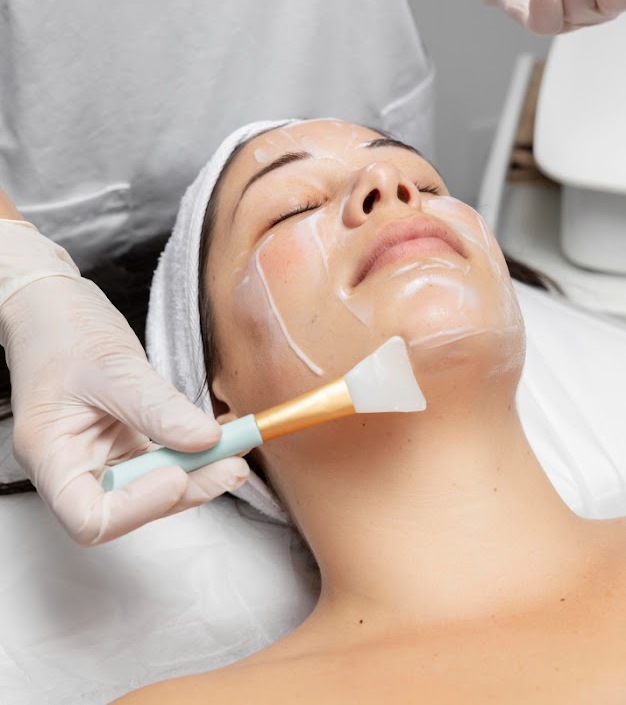
Beverly Hills Plastic Surgeon, Dr. Vallecillos utilizes chemical peels, such as Cosmelan Peel in his practice as one of the multitude of tools to rejuvenate the skin and reverse signs of facial aging. Chemical peel, also known as chemexfoliation or derma peeling, is a non-surgical procedure for improving the appearance of skin on the face, neck, and hands. During a chemical peel, an acidic solution is applied to the skin, left on for a specific duration of time, and then washed off. The type of chemicals used and the strength of the solution will depend on the condition of the skin and the desired results. A superficial peel will only remove the top layer of the skin (epidermis), while a deep peel will penetrate to the dermis. Chemical peels remain the gold standard in terms of rejuvenating the skin, improving the texture, tone, and removing sunspots and age spots.
Procedure Walk-Through
Preparation: Preparation will vary depending on the type of chemical peel to be performed. Generally, no preparation is needed for a superficial or medium peel. Deep peels do require the use of topical agents such as Retin A for up to eight weeks before a treatment, which works by thinning out the skin’s surface to allow the solution to penetrate more deeply. Dr. Vallecillos will provide you with a personalized preparatory regimen during your consultation.
Anesthesia: The type of anesthetic used depends on the type of peel being performed. For superficial and medium peels, a topical numbing agent may be used. For deep chemical peels, a combination of a local anesthetic and sedative is usually required.
Chemical peels are an effective way to treat everything from acne and fine wrinkles to deep scars and blotchy skin tone. Depending on your skin’s condition and your specific goals, Dr. Vallecillos will be able to recommend one of the following types of chemical peels:
Superficial Peel
The superficial peel the least invasive kind of chemical peel. Final results are subtle and may take several treatments to realize, but recovery time is minimal. Usually achieved with a combination of acids like glycolic acid, lactic acid, and salicylic acid, superficial peels are effective on acne scars, light wrinkles, and uneven skin tone. Patients may repeat superficial peels on a weekly basis until desired results are achieved, and then maintain with monthly follow-ups. Doctor Vallecillos often utilizes the superficial peel to condition the skin as a pre-treatment for the Fraxel laser, in doing so, optimizing the result of the laser treatment.
Medium Peel
Medium peels utilize more aggressive chemicals than superficial peels, and remove skin layers from both the epidermis and the dermis. The solution used in medium peels is usually comprised of trichloroacetic acid and glycolic acid. Medium peels are effective on acne scars, moderate wrinkles, and uneven skin tone. Patients commonly experience redness (and sometimes brownness) of the treated skin, which may take up to six weeks to reside.
Deep Peel
This is the most aggressive kind of chemical peel, and the only kind that requires the pre-treatment use of Retin A as well as the use of an anesthetic and/or sedative during the procedure. Utilizing the chemical phenol, deep peels remove layers of skin down to the lower dermis, eradicating deep wrinkles, extensive sun damage, scars, and blotchy tone. It is important to understand that a deep chemical peel will result in peeling, redness of treated skin, and discomfort during the first part of your recovery. It may take several weeks for swelling to reside, and up to several months for redness to fade. However, results should last for years.
Frequently Asked Questions
Who is a candidate for chemical peel?
You should consider a chemical peel if you suffer from any of the following skin conditions:
Light Peel: acne, fine wrinkles, dry or blotchy skin
Medium Peel: scars (including acne scars), moderate wrinkles, blotchy skin
Deep Peel: severe wrinkles, sun damaged, scarred, or blotchy skin, pre-cancerous growths
What is the recovery time of chemical peel?
As discussed above, a patient’s recovery time will depend on the type of chemical peel performed. Light peels have little to no recovery time; most patients find that any redness or flaking resides within a matter of days. Medium peels have a slightly longer recovery time; patients may experience redness, peeling, flaking, and swelling, but these are temporary. Residual discoloration (red or brown skin tone) may persist for up to six weeks. Deep chemical peels have the longest associated recovery time; the treated area is covered in petroleum jelly or tape, which must stay on for several days after the procedure. Redness and swelling may take months to reside.
Are there risks or side effects with chemical peel?
The risks and possibility of adverse side effects increases with the intensity of the chemical peel. Thus, a light chemical peel has the lowest risk factor, while a deep chemical peel has the greatest. Though uncommon when performed by a board certified plastic surgeon, a chemical peel may cause permanent change in skin color (hyperpigmentation, exacerbated by exposure to sunlight), infection, long-term redness of skin, and scarring.
How long do the results last?
Patients may need to undergo several light peels before seeing optimal results, and regular, usually monthly, follow-ups will help to maintain results. Medium peels can be repeated up to twice a year to maintain results, while the results from a deep peel should last for several years. The consistent use of sunscreen as part of a comprehensive skin care plan will help patients to maintain the best possible results.
